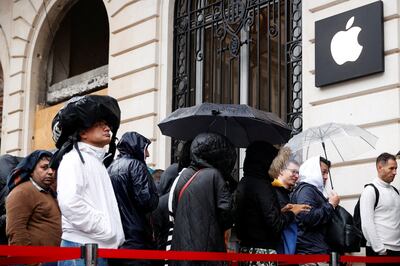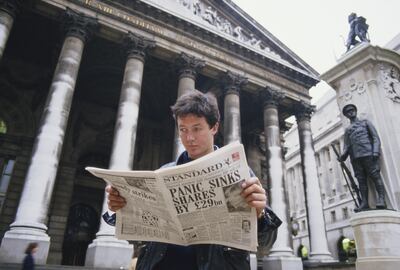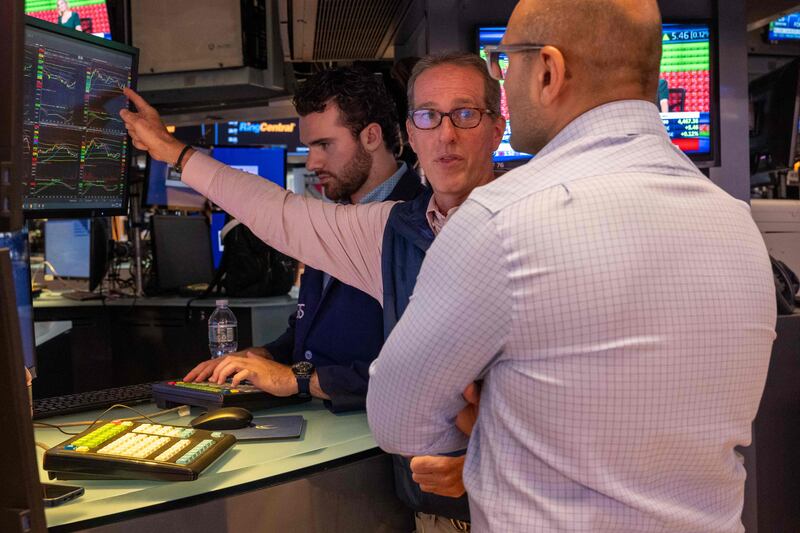On the morning of October 15, 1987, the people of Seven Oaks near London woke to six of their famous trees felled in the Great Storm that killed 18 people.
A week later, the country watched as a Great Crash felled the stock market, causing asset values to plunge and the FTSE 100 share index to fall off a cliff.
Black Monday, as it became known, was the single-biggest global stock market calamity since the Wall Street collapse in 1929, and its effect informed policy and regulation for many years afterwards.
But the financial earthquake on the day itself, 19 October, 1987, was preceded by tremors – signals that something bad was in the offing.
Some analysts now worry that similar tremors are happening right now.
One is the sell-off on the world's bond markets, thanks largely to the impressive strength of the US economy and labour markets in the face of successive rises in interest rates by the US Federal Reserve.
This has led to the prediction that the US Fed and other central banks, including the Bank of England, will keep interest rates higher for longer, sending bond yields soaring and prices falling.
On the flip side, equity markets have had a remarkably good year, fending off the continuing blows of increasing interest rates in a higher-than-usual inflationary environment.
Money manager BlackRock said on Friday its clients were switching to “lock in yields” in significant numbers.
“For the first time in nearly two decades, clients are earning a real return in cash and can wait for more policy and market certainty before re-risking,” chief executive Larry Fink said.
Some market watchers say a worrying tremor for the markets lies in the relative valuations of equity and the debt markets.
According to the global analytics platform Koyfin, in August the S&P 500 share index reached levels not seen since the dot-com boom at the turn of the century, relative to an index that tracks the US corporate bond market.
Crudely put, traders have spent the last several months getting out of bonds and piling into shares.

'Boxed-in central banks'
Earlier this month, economists were surprised when the US labour market added twice as many new jobs as had been predicted, despite the increases in interest rates.
That sent the yield on 10-year US Treasuries up by 14 basis points to 4.86 per cent, before it settled at 4.78 per cent, its highest level in 16 years.
It is not only the US government that is paying more to borrow money, In the UK, 10-year gilts are yielding about 4.5 per cent and the Italian government is paying close to 5 per cent on its debt.
Meanwhile, Germany, whose government bond yields recently crossed into negative territory, meaning investors were in the bizarre situation of paying to lend the government money, now has bond yields about 3 per cent.
“It’s a very delicate situation,” Russ Mould, investment director at AJ Bell told The National.
“Bond vigilantes are making their presence felt and this leaves central banks in a very difficult position.
“Enormous borrowings mean western governments cannot really afford interest rates to stay higher for longer, but cutting them would mean taking a chance with inflation, especially if the Gaza conflict lasts or spreads and drags the oil price higher.
“In this respect, central banks are boxed in, by debt on one hand and inflation on the other, and markets, having gormlessly come to rely upon, or believe in them for so long, now have to face this uncertainty.”
As such, combine falling bond prices with equity market valuations that look increasingly overvalued and the possibility of a crash in share prices becomes less remote than it was six months ago.
'Magnificent Seven'
Nonetheless, there are several caveats to all this. As far as the strength of US equities is concerned, a good portion of it is concentrated in shares of what have become known as the “Magnificent Seven” – Apple, Microsoft, Google parent Alphabet, Amazon, Nvidia, Meta and Tesla.
“The benchmark S&P 500 has risen by 14 per cent this year, which does not carry an immediate portent of despair,” Richard Hunter, Head of Markets at Interactive Investor told The National.
“Some of the gains have been concentrated on a handful of mega-cap tech stocks – the so-called 'Magnificent Seven' – but the underlying economy seems resilient.”
“While there are no clear signs at present, partly due to a robust employment market, it is feasible that the all-important consumer, who accounts for the majority of economic growth in the US, is coming under increasing pressure.”

For the moment, the sell-off in the bond market has had a limited spillover effect on share prices. But for some analysts, contagion is inevitable.
A recent research note from Barclays stated that “stocks have substantial room to re-price lower before bonds stabilise”.
But for Paul Danis, head of asset allocation at RBC Brewin Dolphin, “history shows it is not necessary for stocks to fall significantly for bond yields to stop rising”.
“Most of the time, the bond market doesn’t take its cues from the equity market. More often than not, it's the other way around.
“In the first instance, bonds are driven by variables such as growth, inflation, monetary policy, and supply/demand.
“But there is a non-stop feedback loop between equities and bonds. A major decline in equity prices tightens financial conditions and weighs on growth. This eventually contributes to pulling bond yields lower.”
Asset classes and investment lessons
The bond and equity markets have been tested by a few minor shocks this year already, from the collapse of Silicon Valley Bank, to the intervention by the Bank of England when liability-driven investment (LDI) funds ran into a cash crisis at the end of last month.
But if there's one thing that the shrewd investor has learnt nearly a century on from the 1929 Wall Street crash, it is that diversification is the key because different asset classes react and perform differently at the various stages of an economic cycle.
Having a mix of assets between shares, bonds, property and commodities should mean that the nimble fund manager will not only not have all his eggs in one basket, but should be savvy enough to predict when the bottom is about to fall out of one particular basket.
However, that is not always the way it goes in the real world, Mr Mould said.
“What tends to happen is that trouble in one asset classes forces selling in another,” he told The National.
“Frightened investors see one asset class wobble and decide to protect themselves by taking profits where they can elsewhere, or worse, find that losses in one area force selling elsewhere.
“Forced selling can become particularly acute when leverage, or debt, is involved and investors have borrowed to gear up their positions.
“Once stop losses are hit and margin calls received, then investors have to liquidate and that forced selling can drive prices lower, trigger more stop losses and margin calls and create a cascade of selling.”

'Bumps in the road'
So, the question is: How close might we be to a Black Monday style “cascade of selling” on the stock markets, when the FTSE 100 index lost 11 per cent in one session?
It is certainly possible, given the tremors being felt at the moment and the added uncertainty provided by the world of geopolitics. It does seem that any major shock now could potential be the straw that breaks the camel's back.
Susannah Streeter at Hargreaves Lansdown feels investors should “buckle up for a period of volatility ahead”.
“The triggers are set to be complex and could be a combination of a fresh geopolitical shock, rising energy prices or simply that inflation will stay far too stubborn,” she told The National.
Meanwhile, some economists feel a stock market crash has a certain inevitability to it and would simply be the final curtain call in the decade-long saga of cheap money and soaring debt.
Others, though, are not so sure that total calamity and a serious crash of the equity markets is just over the horizon.
Mr Hunter is a veteran of the City of London's financial markets, having been a broker on trading floors since the 1980s, when paper-based transactions meant information moved through the market much slower than it does in today's fast-fibre dealing environment.
This meant the shock waves from Black Monday in 1987 took longer to wash through the system than would be the case today.
“The investor-driven panic and trading programmes, which at the time were unfit for purpose in 1987 have been replaced today by a more measured approach to the general risk environment,” he told The National.
“This is not to say that there will be no further shocks to come but, for the moment, the market is vigilant and ready to address such bumps in the road.”







